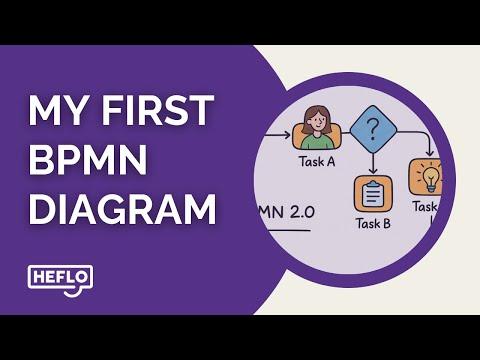5 Practical Examples of BPMN 2.0 Diagrams for Business Process Modeling

Understanding and modeling business processes effectively is essential for improving performance, efficiency, and compliance. That’s where BPMN (Business Process Model and Notation) comes in — a standardized and powerful tool for visualizing and analyzing workflows across any organization.
In this article, we present 6 practical BPMN diagram examples that you can open directly in the HEFLO BPMN modeler. These editable templates provide a solid starting point for process design, and also give you access to a growing library of other ready-to-use processes within the platform.
To complement your experience, we’re also providing a professionally designed PDF document with all the BPMN examples — perfect for reference, training, or team presentations.
Using examples based on BPMN best practices helps accelerate both your learning curve and your organization's adoption of process modeling. By using these ready-made templates, you'll save time and gain access to high-quality, proven process models.
🎁 Bonus: To make your BPMN journey even easier, we’ve included a free video class on BPMN modeling at the end of this article. It’s a great way to deepen your understanding and start modeling like a pro!
BPMN Example #1 - Service Desk
The Service Desk Management Process is a workflow for recording and tracking IT incidents, closely aligned with ITIL practices. Calls first go to Level 1 support, where agents use knowledge bases to resolve issues. If unresolved, the call moves to Level 2, where specialists find a solution. The issue then returns to Level 1 for validation, and finally, the user confirms the resolution before the call is closed.

Click the button below to open and edit this BPMN diagram with your free HEFLO Modeler account.
Also, you can also download a complete, professional documentation of this process map example using the link below. The document was generated by HEFLO after capturing all the tasks.
BPMN Example #2 - Hiring
This example of BPMN diagram outlines the full HR hiring process, emphasizing the value of effective talent acquisition. It defines each stage clearly, specifies the roles of the Requester, HR, and other participants, and supports a smooth, efficient, and candidate-friendly experience.

Click the button below to open and edit the hiring BPMN example with your free HEFLO Modeler account.
Also, you can also download a complete, professional documentation of the hiring BPMN diagram using the link below. The document was generated by HEFLO after capturing all the BPMN tasks.
BPMN Example #3 - Travel Request
This BPMN example illustrates the "Travel Request" process, streamlining employee travel approval and management. It covers the full workflow—from request submission to expense reporting—highlighting key steps, decisions, and roles such as Employee, Manager, Finance, and Admin Support. The BPMN diagram ensures proper authorization, budgeting, documentation, and financial control.

Click the button below to open and customize this diagram using your free HEFLO Modeler account.
You can also download a complete, professionally formatted documentation of this BPMN diagram using the link below. The document was generated by HEFLO based on all captured tasks.
BPMN Example #4 - Consulting Services
This BPMN diagram maps the standardized workflow for delivering consulting services. It encompasses the full engagement lifecycle, beginning with the client request and proceeding through delivery, validation, review, and billing management. Each stage clearly defines tasks, decisions, responsible parties (Client Requester, Consultant, Contract Manager), and associated inputs/outputs. This structured approach ensures a clear, feasible, accurately quoted, successfully delivered, and properly billed consulting engagement.

Click the button below to open and customize this workflow using your free HEFLO Modeler account.
You can also download a complete, professionally formatted documentation of this BPMN diagram using the link below. The document was generated by HEFLO based on all captured tasks.
BPMN Example #5 - Reimbursement of expenses
This diagram shows how employees get reimbursed for legitimate company expenses accurately and efficiently. The employee initiates the process manually, their Manager and Accounts Payable review and approve the claim, and Accounts Payable issues payment and notifies the employee.

Click the button below to open and edit this diagram with your free HEFLO Modeler account.
Also, you can also download a complete, professional documentation of this process map example using the link below. The document was generated by HEFLO after capturing all the tasks.
Free Class - Learn Process Modeling with BPMN
Boost your business process modeling skills with our free BPMN video class. Learn how to create clear, effective diagrams through practical examples—perfectly aligned with the ones featured in this article. Whether you're a beginner or looking to refine your expertise, this session delivers valuable, hands-on insights for every level.

👉 Ready to get started? Create your free HEFLO account to model and document these BPMN diagrams yourself.
